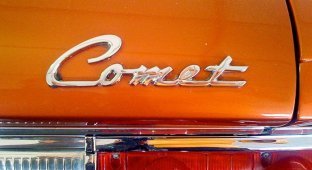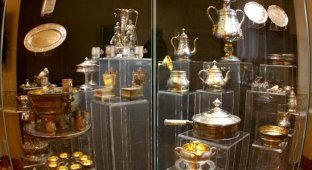
In May 2008, archaeologists from the University of Bristol, conducting excavations on the territory of the Chateau-Gaillard castle (France), made a sensational discovery. At a depth of two and a half meters, a complex of iron objects was discovered that made up the warrior’s protective armor. Nearby, archaeologists discovered a second burial, a well-preserved skeleton of a horse. Also found in the excavation were denier tournois coins, a French type of denarius minted by Philip II Augustus (1180-1223), as well as coins from the Duchy of Aquitaine with the name of Richard, suggesting that the armor found belongs to the reign of Richard I the Lionheart (1189-1199).
Chateau Gaillard was King Richard's favorite castle. He spared no money or effort on it. They say that the king personally chose the place for its construction and actively participated in the development of the project. According to Richard's plan, Chateau-Gaillard was supposed to defend English possessions in the northwestern part of France, since Richard the Lionheart, being the English king, also bore the title of Duke of Normandy.
"On a chalk cliff, shaped like a spur, at the foot of which lies the town of Petit Andely, stands the castle of Chateau Gaillard,
dominating all of Upper Normandy. It is precisely at this point that the Seine, among the rich meadows, forms a wide bend, and Chateau-Gaillard, like a guard, surveys the surface of its waters ten leagues down and upstream. By order of King Richard the Lionheart, it was built within two years, bypassing treaties and with the aim of threatening the King of France from here. Seeing his brainchild, erected on a cliff, sparkling with the whiteness of fresh stonework, surrounded by a double ring of fortress walls, gates, drainage grates, embrasures, with thirteen turrets and a main two-story tower, Richard exclaimed: “What a fun castle!” - hence the name Chateau-Gaillard (Chateau-Gaillard - “jolly castle” (French))" - this is how Maurice Druon describes the castle in “The Prisoner of Chateau-Gaillard”
“My soldiers will take this castle, even if its walls are made of iron,” predicted the French king Philip II Augustus. “My soldiers will defend it, even if its walls are made of butter,” King Richard the Lionheart answered him boldly.
Ten years later, Philip II Augustus, along with other Norman lands, took his beloved fortress from Richard. Since then, Chateau-Gaillard ceased to be a military fortress, it was turned into a royal prison.
Important state criminals were imprisoned here. The one behind whom the drawbridge of Château-Gaillard was removed was never destined to see the world again." In 1314, the castle served as a place of imprisonment for two daughters-in-law of the French king Philip IV the Fair, Margaret and Blanche. Throughout the hundred years' war, the Château Gaillard was subjected to repeated sieges In 1417, it passed into the hands of the British after a sixteen-month siege. Joan of Arc's companion captured it in 1429. But already in 1430, the fortress again fell under the rule of the British. In 1449, Charles VII the Victorious returned it to his possession. At the end the last siege by Henry of Navarre, a royal decree ordered the destruction of the fortifications. The believers of Andelis, the "Capusins" in 1603 and the "penitents" in 1610, received permission to destroy the castle. The collapse of the walls stopped in 1611, when the "Capusins" considered that they already have enough destroyed walls to cover the demand for stone.
In 1852, the ruins of the Gaillard castle were recognized as a historical monument of France. Multiple archaeological excavations were carried out in this area from 1885 to 2000. In 2008, scientists from the University of Bristol, led by Professor John Williams, Doctor of Archaeology, managed to agree with the French government to resume excavations and, apparently, for good reason. The found burial turned out to be unique and attracted the attention of specialists from different countries: archaeologists, historians and even engineers.
What struck scientists as unusual about this find was the very location of the iron armor fragments. From above they resembled the outline of a bicycle.

Imagine the amazement of archaeologists when the carefully extracted fragments were cleared of centuries-old layers of soil and examined in more detail. Without a doubt, these were parts of a knight’s bicycle that had lain in the ground for almost nine centuries!
“This is truly a very unusual find,” says the head of the expedition, Professor at the University of Bristol John Williams, “a bicycle in the 12th century, it’s hard to believe, but during the excavations we had no doubts about the authenticity of the burial.
The good preservation of the metal fragments was soon explained. Spectral analysis of the samples showed the presence of candle wax residues. Apparently, before burial, the surface of the ancient bicycle was treated with molten wax, which prevented the corrosion process from destroying the metal. By the way, about metal.

Even in the Hallstatt era, basic skills in the plastic processing of iron appeared in Europe, with rare attempts to make steel blades by carburizing iron and hardening it. In the subsequent La Tène era, steel manufacturing technology was fully mastered, including quite complex methods for producing welded parts with a high-quality friction-resistant surface.
Metallographic examination of iron parts and the method of microscopic examination of thin sections allow us to say with confidence that the main structural elements of this unusual medieval bicycle are made of steel. As you can see, the recipes for making steel products, practically without any special changes, passed through all of Roman times and had a certain influence on the level of blacksmithing in early medieval Europe.”


Gradually, scientists managed to recreate the appearance of a vehicle that was unusual in the era of knights. Design engineers Steve Berkeley and Andrew Hopkins, who arrived at the excavations from the Science and Technology Center at the University of Cambridge, helped.
“When they called me and informed me that a structure similar to a bicycle had been found in an excavation, supposedly from the 12th century, I exclaimed - incredible! - says Steve, - If it weren’t for the expedition leader, John Williams, whom I know very well, he would have considered this an April Fool’s joke. However, the fact remains that a rare “ancestor” of the modern bicycle was actually found in Chateau-Gaillard. Helping the archaeologists extract fragment after fragment, Andrew and I tried to imagine on the spot in drawings and diagrams the appearance and general design of the bicycle components, how it all could spin and work. To be honest, we gradually developed admiration and respect for the medieval inventor who came up with and implemented such a complex technical project in those days.
It was also interesting to understand the manufacturing technology of each element of this knight-sped.
The frame is as lightweight as possible and has a cloisonne structure, like an airplane wing: steel rods running along the frame are attached to transverse horseshoe-shaped plates. The outside of the frame is covered with elements of knight's armor, in particular, bracers (Bracer) and shoulder pads (Pauldron) are used, fastened together with round rivets. The front fork and rear of the frame are solid forged and covered on the outside (Greav) with greaves. The stem and the handlebar itself are made from sword handles. Parts of the sword blades (apparently deteriorated on the battlefields) were used as rigid profiles to enhance the strength of the structure. The saddle was attached using eight forged metal arches, which served as shock absorbers while riding. The saddle was decorated with leather and fabric, the remains of which were found during excavations.
A horn with a metal lid was attached to the frame as a container for water.

The wheels of this miracle bicycle deserve special attention. To reduce shaking during movement, horsehair was wound around the metal rims, then they were wrapped around the circumference with ribbons of rough leather, and only after that massive iron spokes with an engraved pattern were mounted in the wheel, and the outside of the rim was lined with metal plates that could move relative to each other. during the rolling process. The wheels were reliably protected by “wing casings” made from parts of cuirasses and plate gloves.
How could this “two-wheeled carriage” move?
Andrew Hopkins says:
- Two metal disks with pointed teeth along the edges were found in the excavation. One disc was dug up in the rear wheel area. The second disk was found in the area of the lower part of the frame, with a sword handle attached to it (apparently an ancient prototype of a connecting rod) along with metal parts resembling pedals in appearance. Remains of a chain with decorative overlays were found between the discs. It can be assumed that we are faced with the first example of a transmission, a chain transmission mechanism, used in medieval Europe. Although chain transmission has been known to people for a long time, Heron used the first such mechanisms to move scenery in the Athenian theater. It’s still amazing how medieval craftsmen were able to realize such a mechanism in metal in the 12th century.
Is this the twelfth century?
Scientists' opinions on this matter are divided.
“The coins could have gotten into the excavation by accident, during excavation,” says professor of archeology Pierre Justin, a representative of the French Academy of Sciences, who participated in the excavations at Chateau-Gaillard. “I, as a specialist in knightly weapons, believe that parts of the cuirass (Cuirass) , Bracers, Gauntlets and Mitten Gauntlets, which were used in the manufacture of this undoubtedly outstanding find, date back to the second half of the fifteenth century, but not the twelfth century and are of Italian origin. On some parts of the armor the mark of a master of the Milanese school of armor from the Missaglia dynasty was found. And most importantly: X-ray structural analysis of the metal fragments of the cuirass revealed a structure almost identical to Milanese armor made in a similar period of time."
Here is a quote from a reference book on knightly weapons:
“Milanese armor - “Milanese armor”. Italian full armor of the 15th century, a contemporary of Gothic armor, differing from it in more rounded shapes and fewer grooved parts. Mainly produced in Milan and Venice"
Scientists argue about the details of the discovery, but none of them questions the sensational nature of the find itself.
Where did the bicycle come from in the Middle Ages?
To answer this question, a world-famous expert on the history of the bicycle, Dr. Pieter Godward from the Faculty of History and Archaeology at Cardiff University, arrived at the excavation site.
“The bicycle is an older invention of human civilization than we think,” says Peter Godward, “The sensational discovery at Chateau-Gaillard confirms the results of many years of research by scientists at our university. Back in 1962, news spread throughout the world about a unique find by French archaeologists on the territory of Versailles. Then, during excavations authorized by the French government, a side gallery was discovered in one of the wells, which led to the vast dungeon of the palace, where, among other items, a bicycle was found.The bicycle soon received the name “Sun King” in honor of King Louis XIV.

At that time, the unexpected find caused a lot of controversy among archaeologists and historians; many considered it a fake.
Discussions have reached our university. Then, in 1962, having familiarized ourselves with the materials of the excavations at Versailles, we decided to seriously take up the “bicycle” issue. And they even created an international research center dedicated to this problem, which brought together like-minded scientists from several leading universities in the world. Over the years, we have been collecting information in archives, communicating with collectors, participating in archaeological and ethnographic expeditions, studying historical documents, works of literature and art. We spent a lot of time in the storerooms and collections of the largest museums on the planet. And everywhere we were interested in one thing - BICYCLE.

In 1986, we received a call from a representative of the world famous art collector, co-founder of the Sothebyes auction house, Andrea Castilles.
Mr. Castilles, a former road cyclist who competed in the 1951 Giro d'Italia and the 1955 Tour de France, turned out to be an avid collector of all things bicycle. He kindly invited us to visit, promising to show us something amazing.
What we saw exceeded our wildest fantasies.
We all know the famous Italian artist Sandro Botticelli (1445-1510), the author of many masterpieces of painting, including “Spring” (1478) and “The Birth of Venus” (1484-1486). From 1492 to 1500 Botticelli creates a grand cycle of drawings of illustrations for Dante's Divine Comedy. The drawings are made with a metal pin on large sheets of parchment. Almost all of them are outlined with a pen. One drawing is dedicated to each song. Several drawings for “Paradise” are not finished, and for the XXX1 song “Purgatory” the master completed two versions of the drawing. One of these two drawings is in the collection of Andrea Castilles.

In this illustration of an apocalyptic vision, a sacred cortege led by seven angels is flanked by biblical animals: an eagle, a winged calf, a winged lion, and an angelic man with a book. A griffin is harnessed to the carriage with Beatrice seated.
"Two-pronged, between four beasts
The victory cart rose
And the harnessed Griffin walked in front of her.”
(Dante’s “Divine Comedy”, “Purgatory” part XXXI)
“Pay attention to the figure of a man at the bottom of the illustration, greeting the procession,” explains Mr. Castilles, “what do you see next to him?” This is a BICYCLE!
Shocked, we bent over the yellowed parchment and began to carefully peer at the image.
And at this time, a massive container was already being rolled into the hall on a special trolley. Its front wall was made of thick glass. Behind the glass we saw a small picture where a bicycle was depicted in color, very similar to the one we had just looked at in the illustration to the “Divine Comedy”

“This is a very rare work by Botticelli,” Andrea commented, “yes, don’t doubt it, it’s not a fake! I’ll tell you, as scientists: a comparative spectral and chemical analysis of the composition of tempera paints, soil and even wood fibers was carried out, this and another work by Botticelli, the portrait of "St. Augustine" (1495). The compositions are identical. By the way, the background of "St. Augustine" and this painting are very similar. Apparently Botticelli created both works at the same time. In the originality of the decor of this, clearly feminine version of the bicycle, there is a connection with the master’s earlier masterpiece, “The Birth of Venus.” Art historians have found that during Botticelli’s lifetime this “portrait of a bicycle” did not find recognition among viewers. The artist’s contemporaries apparently did not understand at all what was depicted here. It also remains a mystery to me: how he came Botticelli to the idea of such an unusual work? Why is the bicycle clearly a woman’s? And what does “The Divine Comedy” have to do with it? Beatrice’s bicycle? You are scientists, you should look for answers...
Soon after the artist’s death, the painting was completely forgotten, was kept for a long time in the State Museum in Berlin, disappeared during the Second World War and came to me completely by accident, but that’s a completely different story...
“I have something else, follow me,” Andrea Castilles, in his sixties, a respectable gentleman, an aristocrat, smiled slyly, like a youth. Apparently, the main surprise was ahead.
We, following the owner, crossed the courtyard of the family castle (Andrea Castilles, lives on the family estate and is proud of his knightly roots) and climbed the stone steps into the round tower. Inside, the medieval tower has undergone a major renovation and has been transformed into a modern multi-tiered exhibition space with unique lighting and thoughtful presentation of each work.
“This is Holbein, the same Hans Holbein the Younger (German: Hans Holbein, 1497-1543) painter and draftsman, one of the greatest German masters of the Renaissance, an outstanding portrait painter, court artist of Henry VIII,” Andrea led us to one of the niches. - You see the work of 1540. In the same year he painted the famous portrait of Henry, now kept in the Roman National Gallery. They are somewhat similar...
We were shocked and stopped dead in our tracks - the picture depicted a brutal-looking two-wheeled miracle with frightening authenticity!

“The bicycle reincarnation of Henry the Eighth,” I blurted out.
- And again there is a mystery that you have to unravel. We see the same bicycle in one of Halbein’s earlier drawings,” Andrea pointed to a glass display case next to the niche, where several yellowed sheets lay

- Maybe the artist depicted the inventor himself next to his brainchild. However, judging by the faces of those around him, he is doomed to condemnation and misunderstanding. At all times, people have been afraid of the new and unusual...
- And this is a painting by the Flemish painter of the early Renaissance, master of portraiture, Jan van Eyck (c. 1385 -1441). Everyone knows his masterpiece “Portrait of the Arnolfini Couple,” but hardly anyone knows his other painting from the same period , - we come to the next niche.
And again a miracle. Absolutely fantastic in concept and at the same time unrealistic, brilliantly executed cycling fantasy of the artist. Now we knew for sure that Van Eyck not only invented oil paints, he was also the inventor of a wonderful bicycle.
- A sort of bike for a noble nobleman, “I sit high, I look far away,” look, there’s even a ladder for climbing. Pay attention to the pedals and transmission, and what wheels... - Andrea spent a long time telling us with inspiration about these exhibits that were dearest to his heart.


Castilles also told us that similar emblems were found on the reverse side of Botticelli’s work, on the x-ray of Holbein’s painting and on the oak board with Van Eyck’s bicycle. This is a medieval shield depicting a crowned lion resting on two wheels, and above it is a rising sun and a crescent moon. What would that mean? Knightly Order of Cyclists? Then we all laughed together, not imagining how close to the truth these words would be.
The meeting with Andrea Castilles took place in 1986. Saying goodbye he said:
“The bicycle is not just a means of transportation, it is a means of creative expression, a way of life and a worldview, I would add, a worldview. Why did such famous artists depict a bicycle? Because they, having experienced a feeling of true freedom at the moment of the creative act, could not pass by this amazing, in its simplicity, two-wheeled “freedom generator”. The invention of the bicycle, as a way of understanding the world and the path to freedom, is a great topic for research! Go for it, New discoveries await you."
The discovery at Chateau-Gaillard is yet another confirmation of this.
Was there an order?
“Since 1962, our center has accumulated a lot of factual material,” Peter Godward continues his story, “and today we can say with a fair degree of certainty that in the 12th-15th centuries a secret organization arose in Europe calling itself the “Knightly Order of the Sun and Moon.” The knights and members of this order moved with the help of two-wheeled carriages, “iron horses”; in fact, these were the first cyclist warriors of the Middle Ages. According to scientists, they could well have participated in hostilities along with ordinary knights. The speed, maneuverability and invulnerability of the “iron horsemen” posed a serious danger to the enemy. And the unusual, apocalyptic appearance of the warriors rushing with a wild clanging over the ground without the help of horses familiar to the eye, contributed to the surprise of the attack and could turn the enemy into a stampede. The knights of the order could make long trips with minimal supplies of food and equipment, since they did not require maintenance and feeding of horses. History knows examples of the participation of cyclist warriors in hostilities. In 1885, a military unit, the Brighton Rifles, was even created in Britain, which for the first time confronted the cavalry on high bicycles with large front wheels (the so-called “spiders”). The experience was considered successful, and in the Anglo-Boer War of 1899–1902. The British army successfully used bicycles on a massive scale. Bicycle parts were created in France, Germany, Italy, Belgium, Switzerland, China, Japan and Russia. In both the First and Second World Wars, army cyclists performed well.


We find the first mention of the mysterious “Order of the Sun and Moon” in the manuscript “Acts of the Romans” (FAITS DES ROMAINS). "The Acts of the Romans" is a historical narrative in prose, setting out the history of Rome and beyond, being a revised French compilation of the works of Sallust, Lucian and Suetonius. The approximate dates of creation of the work are 1230-1240s.
In this miniature from an ancient manuscript, we see ahead of the army emerging from the fortress, an armed warrior riding on a two-wheeled cart that surprisingly resembles a bicycle. Let's pay attention to the warrior's shield. On the red background of the shield we see, in the language of heraldry, a rising lion resting on two wheels. This is one of the first images of the coat of arms of the knights of the Order of the Sun and Moon.
We managed to find later versions of this coat of arms in several more historical documents.
For example, in the General Armorial of the 14th century (the Bellenville Manuscript), the coat of arms of the king of England is accompanied by the coats of arms of his vassals. Among others, there is the coat of arms of this secret order.


And this is a fragment from a 15th century armorial. Again the same coat of arms.

The red shield of the coat of arms depicts a rising golden winged lion with a crown on its head, resting its front and hind legs on two wheels.
In the full version of the coat of arms, the rising Sun is depicted above the shield, on top of which is the Moon. Also present on the coat of arms are shield holders: an anti-rebellious silver winged lion and a griffin, each of which rests on a wheel. Below, on a stylized ribbon, the motto of the order is written in Latin letters: “IN VELOX LIBERTAS.” This can be translated as follows: “freedom in speed”, “liberation in speed” or “faster to freedom”
The translation is ambiguous, as is the symbolism of the coat of arms itself.

The lion has been one of the most common symbols of strength and greatness for thousands of years. General symbolism: divine, solar energy (symbol of fire and the Sun), royal power, strength, courage, wisdom, justice, patronage, protection. Leo is the main figure for personifying the Sun itself. The winged lion represents power and lightness at the same time. In medieval Scotland and England, the lion personifies royal power; it is the main symbol of the power of the British Empire in the 19th century (“British Lion”).
Richard 1 (1157-1199) was called “Lionheart” for his bravery.
The griffin is a solar hybrid creature combining the head, wings and claws of an eagle with the body of a lion. Since these animals symbolize power over the air and earth (the king of birds and the king of beasts), the griffin is an impressive symbol of strength and vigilance. It has become popular since the 2nd millennium BC.
“The Moon and the Sun, forever rolling across the sky, alternating day and night, apparently symbolized for the members of the order the two wheels of their unusual means of transportation, rapidly carrying them to freedom,” suggests Peter Godward, “the wheel is one of the main symbols of the cosmic driving force, which governs the planets and stars, and continuous change and repetition. The first wheels were solid, so their early images differ only slightly from the disks that represented the Moon and the Sun. The spoked wheel appeared around 2000 BC. e. and assigned solar symbolism to it. The wheel is a symbol of solar energy. The Sun is a wheel turning in Heaven: the Sun is the center, and the spokes of the wheel are the rays.
On a bicycle, one wheel overtakes the other, just as the Moon always overtakes the Sun in the sky. The most archaic form of the solar myth appears to be twin myths, in which the Sun and Moon form a pair of related and at the same time opposed cultural heroes (often brothers), one of whom is subordinate to the other and carries out his instructions.”
We also find the Moon depicted on top of the Sun on the modern coat of arms of the city of Milan, and the winged Lion associated with the name of St. Mark is a symbol of Venice.


Why Italy and Milan?
Pierre Justin comments:
“The symbolism of Milan and Venice in the coat of arms of the knights of the Order of the Sun and Moon is not accidental and suggests that they most likely made their unique, at that time, means of transportation in Italy, in the same craft workshops where knightly knights were produced. armor. The most durable elements: load-bearing parts of the frame, wheels, seat, elements of the steering wheel and rotating mechanism were made by master gunsmiths. For example, the embossed handlebar of a bicycle found in Chateau-Gaillard is made from the handles of two swords connected by a bronze bridge.
According to Galvano Fiamma's (1298–1344) Chronicon Extravagans, Milan became a major center for the production and export of armor. I can’t say about the 13th century, but in the middle of the 14th century. there was no longer any doubt about this, for English and French texts, starting from this time, constantly talk about armor from Lombardy and Milan. From the Datini archives we also know that in the 60s. XIV century all of Northern Italy exported large quantities of armor to all European countries, especially France and Spain. This continued throughout the 14th century, as well as in the 15th and 16th centuries. Italian craftsmen were so skilled that they could make armor in the style of the countries to which they were exported, and even the Germans, having in the 15th century. their own major armor production centers, imported German-style armor from Milan.
Apparently, the most famous Italian masters of the 15th century. came from the Milanese family of Missaglia, or, to put it in full, de Negroni da Ello detto Missaglia. It was the mark of one of the Missal workshops that was found on a fragment of a cuirass from which the fender of a bicycle found in Chateau-Gaillard was made. I am sure that the ancient bicycle dates back no earlier than the fifteenth century and is of Italian origin. And I don’t see any reason for further discussions.”
However, the head of the excavations, Professor John Williams, has a different point of view: “It seems to me that the armor of representatives of different schools was used in the bicycle found. In particular, corrugated armor (French armure cannellee, Maximilienne, um. armature spigolata), erroneously called “Milanese armor” among collectors, can be considered as an invention of Maximilian I (1459-1519), who, thanks to corrugation, decided to strengthen the armor without increasing it thickness and weight. Now researchers call them on this basis more correctly “Maximilian armor” (c. 1475). This kind of armor is German, mostly made in Nuremberg.
The found bicycle uses “Maximilian” shoulder pads (German: Achseln, French: epaulieres, Italian: spallacci, English: shoulder plates, pauldrons), front (facial) wings (German: Vorderfluge, French: ailes, Italian: ale, lunette) and bracers (German Armzeug, French brassards, Italian bracciale, English brassards, vambrage).
As for the fragments of cuirass, plate gauntlets, gloves (German Handschuhe, French gantelets, Italian manopole, English gauntlet) and leggings (German Stulpen), they are of Italian origin.”
They did it...
In the summer of 2008, the story of the discovery in Chateau-Gaillard received an unexpected continuation...
The already mentioned Steve Berkeley and Andrew Hopkins, engineers from Cambridge, who took an active part in the excavations, turned out to be avid cyclists and, literally, were inspired by the idea of reconstructing a unique bicycle. But we were not talking about a model, not about a dummy. They decided to recreate a full-size copy of it in metal, in all the little details and in such a way that they could move around on it.
It was decided to use a converted frame of a regular bicycle as a frame. Welding and plumbing work was carried out by specialists from the scientific and technical center. But the main task was to restore the “knightly costume” of this unique monument of medieval engineering. Where can we find gunsmiths and armor makers who could handle such intricate work?
Steve and Andrew traveled all over northern Italy, not to mention Milan itself, trying to find the keepers of the traditions and secrets of the craftsmanship of the famous Missaglia dynasty. The engineers were convinced that it was the Milanese craftsmen, who brilliantly imitated different techniques and schools of armor, who could produce such an eclectic and varied style bicycle.
As always, “His Majesty’s” chance helped. Peter Godward, the chief bicycle expert, being aware of the problems of two young archaeological engineers, decided to call his old friend, now 82-year-old collector Andrea Castilles, and find out if he had any worthy gunsmith restorers in mind.
Peter also sent him photographs from the excavations at Chateau-Gaillard. The answer came immediately.
And what an answer!
Andrea knew an Italian master, whose ancestors were blacksmiths in Milan back in the 9th century. At one time, he even bought from this man ancient drawings and drawings of the 14th-15th centuries from the family archive and supported him with orders in difficult times.
Andrea urgently met with Giovanni Ferrelli, that is the name of this master, and showed him photographs, drawings and diagrams of Berkeley and Hopkins. Giovanni's reaction was emotional in Italian. As Castilles writes, “He raised his eyes to the sky and whispered, “Oh, Santa Maria! This can’t be!” and began silently, barely holding back tears, shaking photographs in front of me like a madman.
It turned out that Giovanni Ferrelli’s family archive contained drawings of our bicycle. It's impossible to believe, but it's a fact.

Andrea sent us photocopies of these ancient images. There were schematic drawings with all the technical details, dimensions, methods of fastening parts, etc., sketches with patterns for embossing and etching, technological explanations, and even a method of hardening the metal was described. In short, everything you need for a complete authentic reconstruction. By the way, on one of the drawings in the upper right corner there was a mark of the Missaglia clan of gunsmiths, and on some others there was a winged crowned lion resting on two wheels.
Giovanni also said that restoring this bike is a matter of honor for him. It was fate!


Six months later, a whole team of “iron craftsmen” under the strict guidance of Giovanni Ferrelli completed their work. Steve Berkeley and Andrew Hopkins, the initiators of the project, were happy that their dream had come true. You can see what happened in this photo. The two-wheeled “handsome man” was named “Richard the Lionheart”, in honor of the legendary owner of the Chateau-Gaillard castle, whose land was protected for so long, and finally revealed its amazing secret to archaeologists.

The Earth keeps many secrets, but there are even more unknowns in man himself.
Knights of the “Order of the Sun and Moon”... Who were these people who threw their motto “IN VELOX LIBERTAS” into the grinning jaws of the dark, cruel Middle Ages?
For the first time in many millennia, a man rode, moving himself, and the driven horse did not wheeze under him. He rushed through forests and fields, with his efforts rotating the Sun and the Moon, setting the entire Universe in motion, and felt equal to God.
What could a man shout when he first accelerated down a mountain on his “knight-ciped”? - “FASTER TO FREEDOM!”
They did not acquire, they served and gave of themselves. A bicycle is the most knightly means of transportation. A cyclist gives his strength, and does not take the strength of others. He is in harmony with nature, and does not enslave it.
And more deeply, the attitude towards a bicycle predetermines a person’s choice in the main questions of existence: To Have or To Be? Take or Give? Find your own path to yourself or follow the path that others have chosen for you?
Everyone decides for themselves.
As the old knightly motto says: “Fais se que dois, - adviegne que peut” (French)























